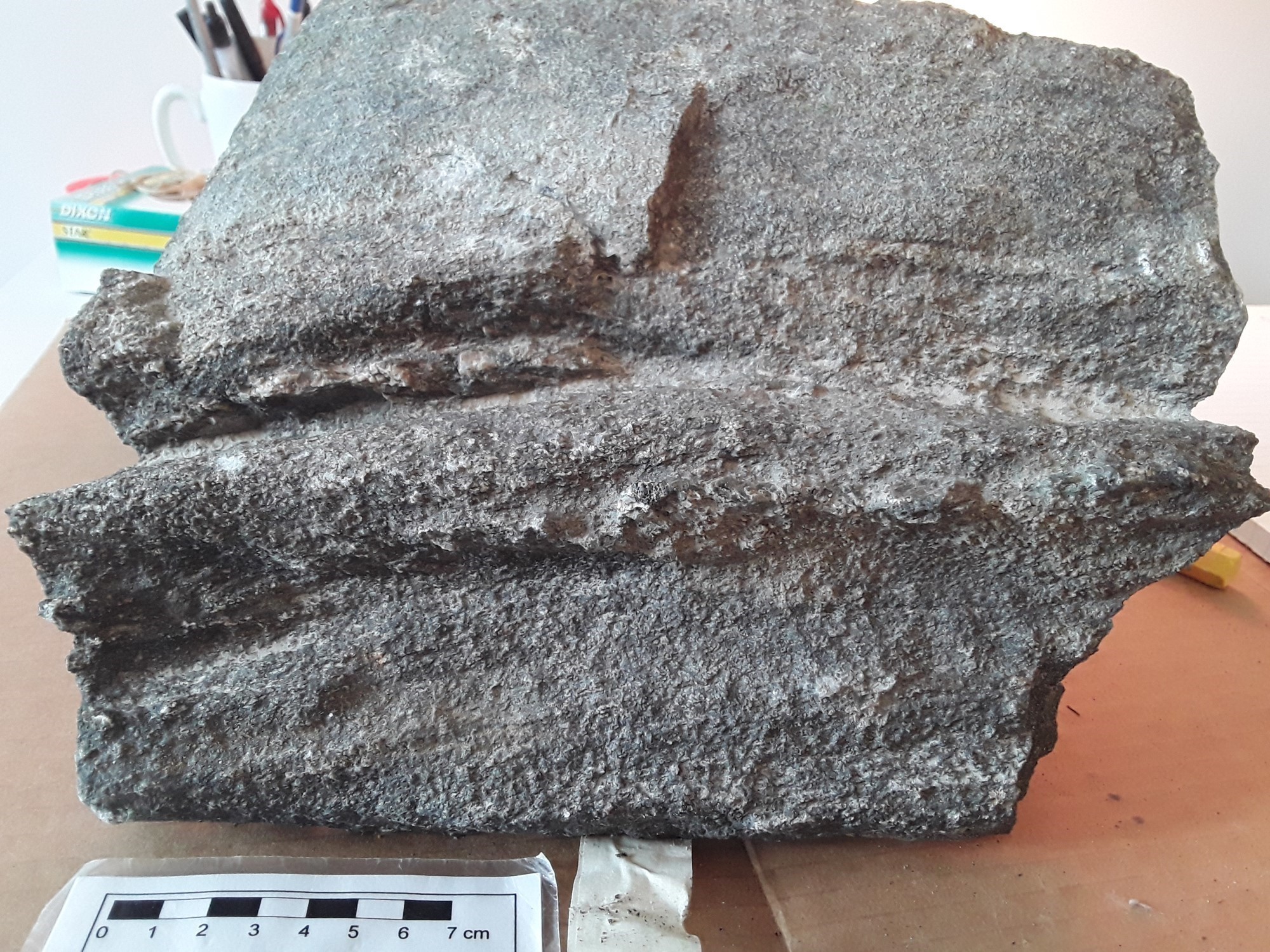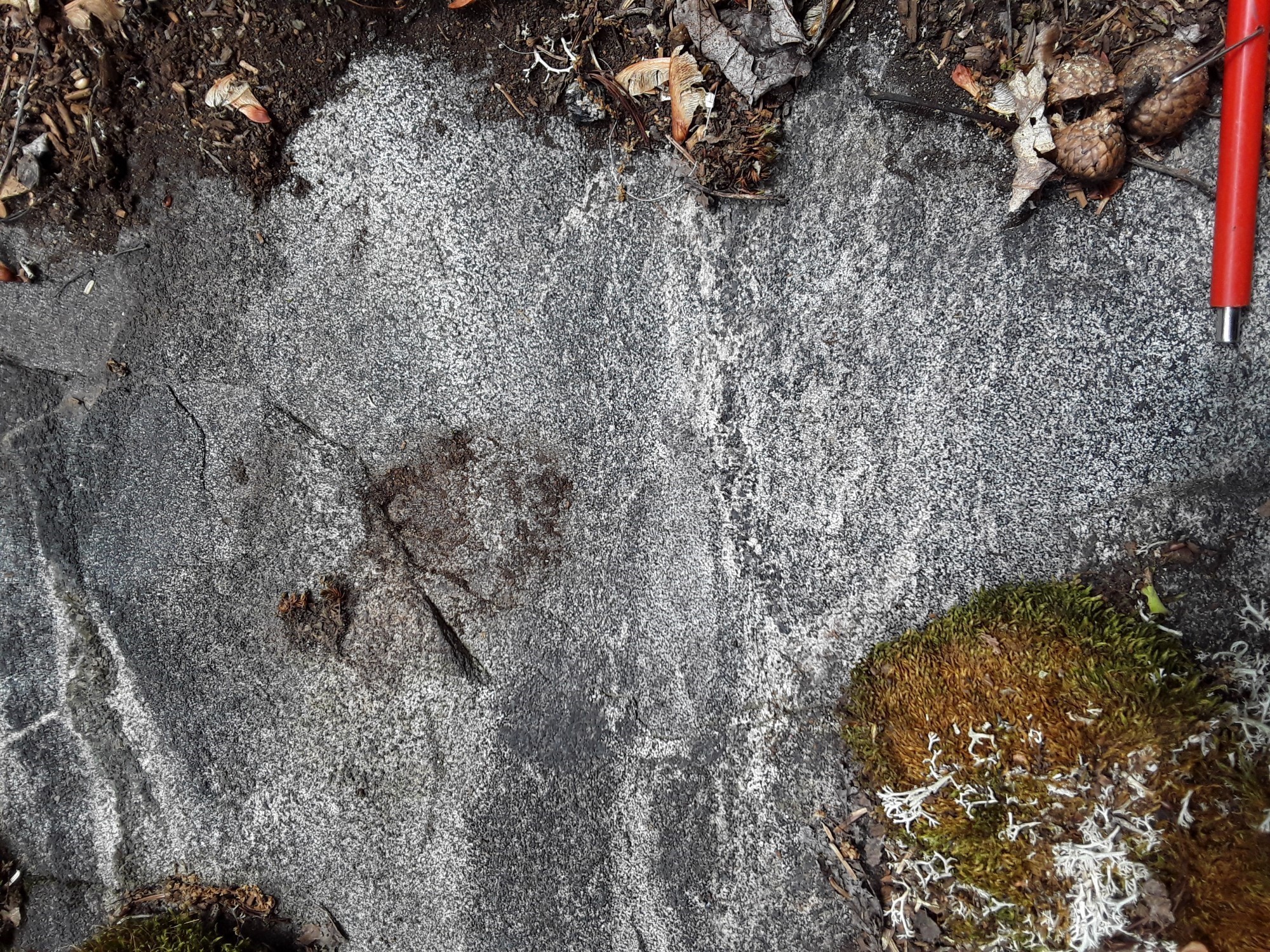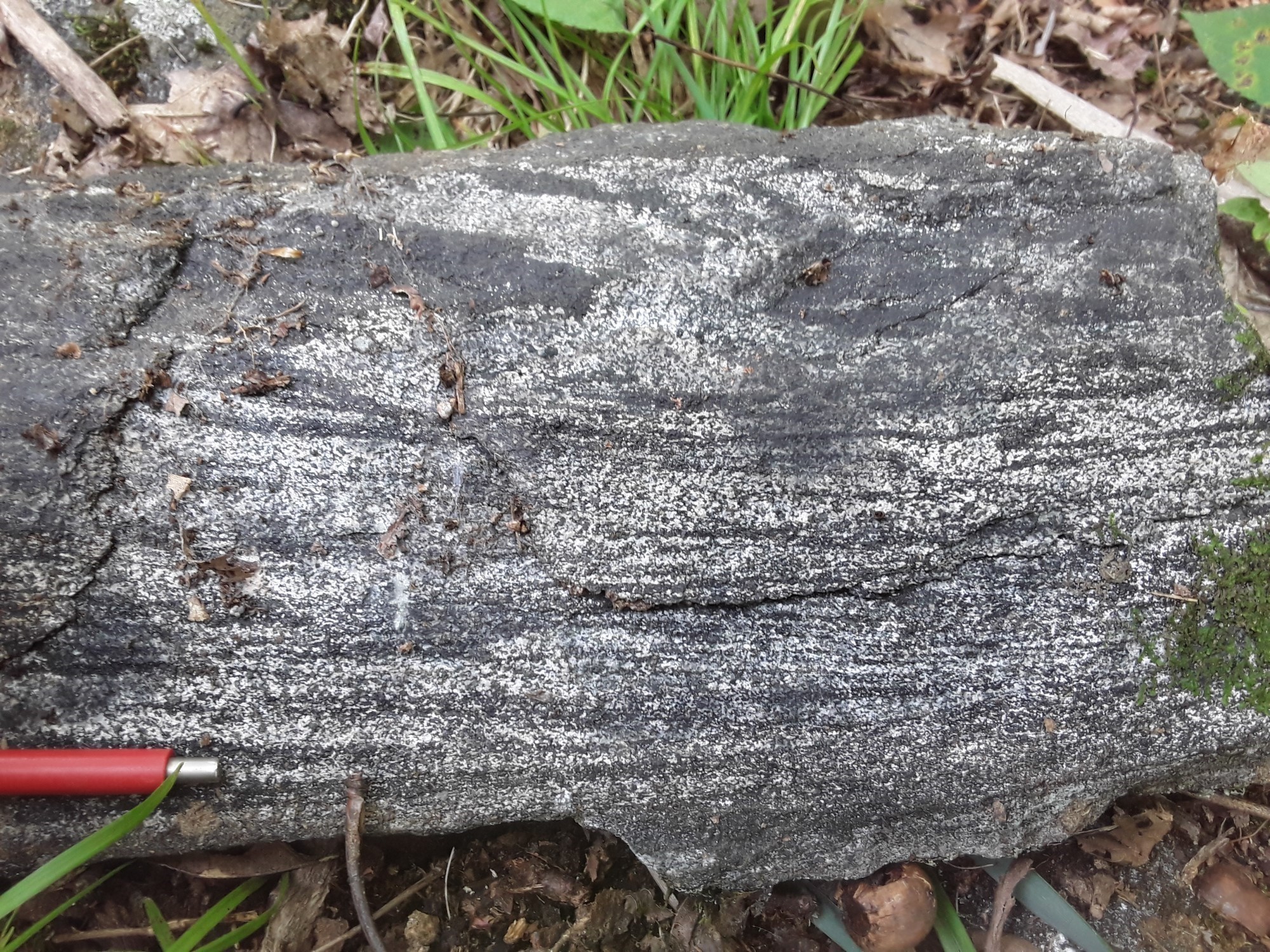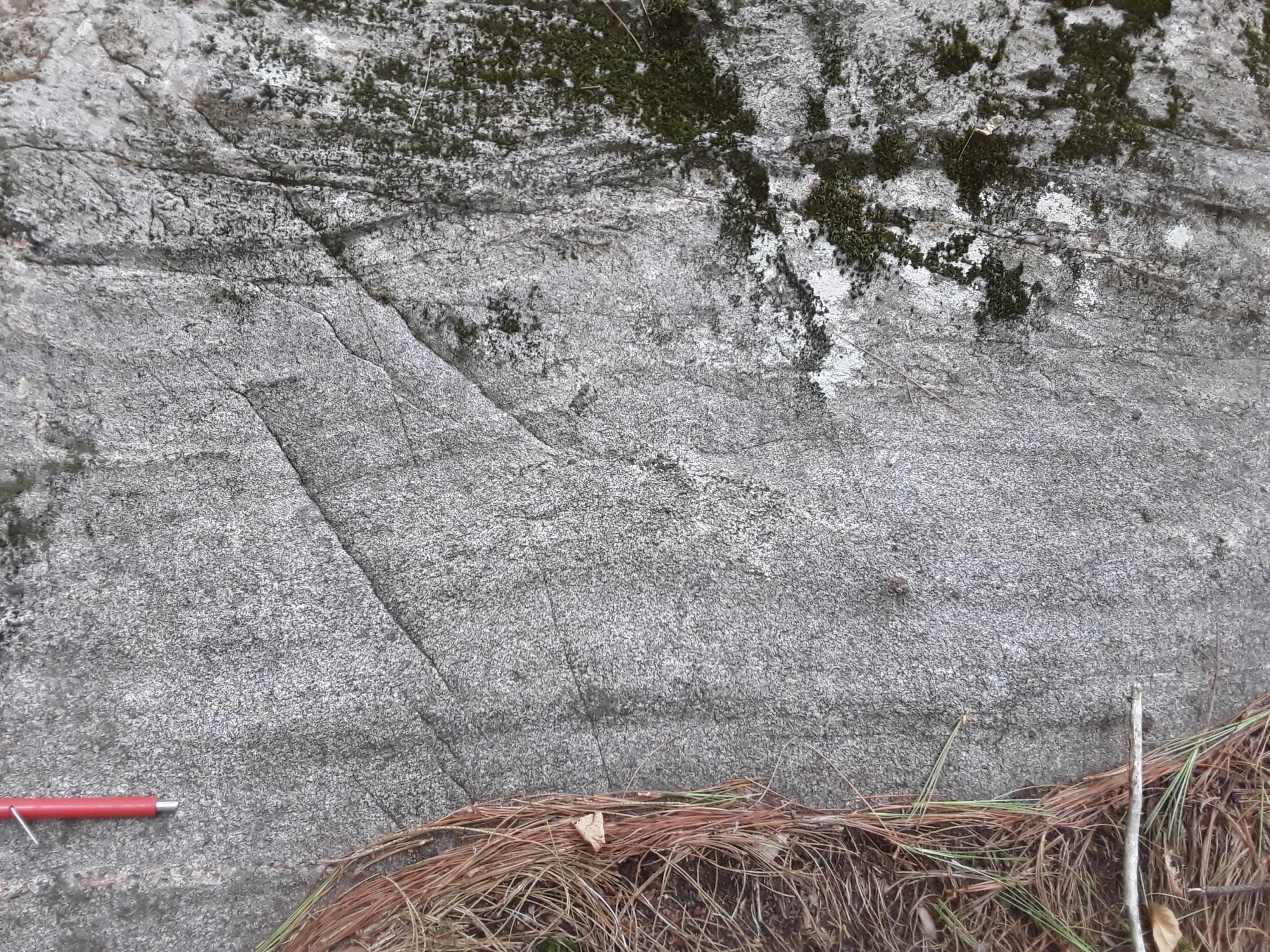
DISCLAIMER: This English version is translated from the original French. In case of any discrepancy, the French version shall prevail.
| Author(s): | Bilodeau, 2022 |
| Age: | Mesoproterozoic |
| Stratotype: | Reference outcrops 2021-CB-1009, 2021-CB-1065, 2021-CB-1139 and 2021-CB-1288 |
| Type area: | Île-du-Grand-Calumet (NTS sheet 31F10) |
| Geological province: | Grenville Province |
| Geological subdivision: | Allochton |
| Lithology: | Mafic metavolcanic rocks, mafic intrusive rocks |
| Category: | Lithodemic |
| Rank: | Complex |
| Status: |
Formal |
| Use: | Active |
None
Background
The Grand-Calumet Complex was introduced by Bilodeau (2022) to group all the metavolcanic rocks and other associated lithologies in the Île-du-Grand-Calumet area. The unit has been defined and mapped on several occasions over more than a century, since it hosts a number of mineralized zones, including the former New Calumet Mine. The first comprehensive and adequate description of the unit comes from the work of Osborne (1944), who described alternating facies of mafic gneiss cut by a mafic rock. Subsequent work has strengthened the hypothesis proposed by Bishop (1987) and Gauthier (2015) suggesting that the unit is of volcanic origin.
Description
The Grand-Calumet Complex consists mostly of amphibolite interpreted as basalt-derived rocks (mPgrc1). These rocks are associated with mafic intrusive rocks (mPgrc2) whose emplacement is considered to be contemporaneous to volcanic rocks. This subunit is composed of two main facies: fine-grained gabbro and gabbronorite.
Grand-Calumet Complex 1 (mPgrc1): Amphibolite derived from hornblende-biotite-magnetite basalt
Unit mPgrc1 consists of different facies of hornblende ± biotite ± magnetite ± garnet amphibolite. The unit is typically characterized by a rock with alternating bands of amphibolite containing biotite, garnet and small hornblende phenocrysts, and bands of magnetic amphibolite containing hornblende but not biotite. A pyroclastic facies has also been observed in the area of the New Calumet mineralized zone (Gauthier, 2015). The rocks are generally highly recrystallized with an increase in crystal size, giving them the appearance of very fine-grained gabbro in places.
The amphibolite’s alteration patina is variable in colour, generally light brownish-grey to brownish-grey to very dark greenish-brown and locally slightly light grey or rusty. The fresh surface is grey to very dark grey, and locally brownish-grey. The unit is generally banded, with a fine to medium grain size and is fairly homogeneous overall. Bands vary in grain size and composition over centimetric thicknesses. The rock is typically composed of 20% to 40% fine-grained euhedral dark olive-green hornblende and 40% to 45% recrystallized and locally antiperthitic plagioclase. Slight late damouritization is locally visible along the cleavages. Up to 20% fine epidote is present in clusters, indicating saussuritization of the plagioclase, which varies from slight to complete depending on the sample. The distribution of hornblende and plagioclase is generally homogeneous in each band.
Bands contain up to 15% orthopyroxene and 10% clinopyroxene, fine-grained or in medium-grained relicts. Bands also contain a highly variable proportion (5-25%) of fairly fine biotite, homogeneously distributed and generally associated with hornblende. The biotite varies in size in some samples. The amphibolite is considered slightly or not uralitized. However, some bands contain phenocrysts a few millimetres in size of poikilitic hornblende, possibly replacing pyroxene, which contains numerous inclusions of plagioclase and clinopyroxene. Foliation is marked by hornblende and biotite. The proportion of sulphides and magnetite varies from 0% to 8%, reflecting differences in the intensity of magnetic susceptibility in outcrop, a property estimated to be regionally lower than that of the surrounding units. Up to 3% quartz in isolated coarse crystals and <1% garnet, tremolite, carbonate chlorite, and epidote occur locally.
Grand-Calumet Complex 2 (mPgrc2): Fine-grained gabbro, gabbronorite
Unit mPgrc2 is a heterogeneous mafic intrusive subunit consisting of two main facies: 1) fine-grained gabbro, and 2) gabbronorite.
Fine-grained gabbro facies
Gabbro is typically very fine grained, massive, homogeneous and recrystallized. The rocks are locally heterogeneous, heterogranular and foliated. This heterogeneous variety is characterized by a slight compositional or granulometric banding interpreted as being of magmatic origin.
This gabbro has a grey to dark grey, locally black, patina and a dark to very dark grey altered surface. The rock is composed of 50% to 60% fine to medium plagioclase grains. Some samples are slightly damouritized. The microgabbro contains 35% to 45% fine hornblende very homogeneously distributed and defining a slight foliation. The presence of hornblende clusters indicates an almost complete replacement of clinopyroxene due to uralitization. Clinopyroxene relicts represent ~5% of the volume of the rock. Gabbro contains 3% to 5% biotite without preferential orientation, a phase considered to be secondary and occurring later. The rock contains up to 1% pyrite and very little magnetite, as evidenced by its low magnetic susceptibility. Small enclaves, only a few centimetres in size, of fine-grained mafic composition have been observed locally.
Gabbronorite facies
Gabbronorite is mesocratic, homogeneous, massive and locally granoblastic. It has a brown to dark grey alteration patina and a brownish-grey or very dark grey fresh surface. It is composed of 60% fine to medium unaltered plagioclase grains and 15% to 25% fine euhedral hornblende. The rock contains approximately 12% to 15% fine unaltered orthopyroxene, which is fairly homogeneously distributed and appears to have crystallized later than hornblende, and 3% clinopyroxene heterogeneously distributed. Pyroxene crowns are locally replaced by hornblende, and replacement is complete in some samples (up to 15% of the volume of the rock). The rock contains up to 5% subhedral to anhedral garnet of variable grain size and heterogeneous distribution. Accessory minerals include traces of quartz and up to 5% opaque minerals, including 1% sulphides. Unlike other lithologies in the Grand-Calumet Complex, the gabbronorite does not contain biotite. Magnetic susceptibility varies from very low to high.
Thickness and Distribution
The rocks of the Grand-Calumet Complex occupy almost the entire southern half of the Île-du-Grand-Calumet municipality. They are the only known example of this type of rock in the area. Similar metavolcanic rock units have been identified in other parts of the Central Metasedimentary Belt (CMB), in Ontario (Rivers, 1989). The thickness of the unit is unknown.
Dating
A sample of fragmental metavolcanic rock from the Grand-Calumet Complex was dated by J. David (in Gauthier, 2015). The zircons gave a U-Pb crystallization age of 1232.8 +3.9/-2.7 Ma.
Stratigraphic Relationship(s)
The amphibolite layer (mPgrc1) form a more or less rounded massif in the southern half of Île-du-Grand-Calumet. Recent geochemical analysis data suggest a complex stratigraphy within the volcanic pile. A broad-scale geochemical zoning is vaguely discernible, since samples taken from the central part of the unit have a geochemical signature of tholeiitic affinity, while those taken from the outer part have more of a transitional to calc-alkaline affinity. The gabbro intrusion (mPgrc2) located in the southern part also has a very similar calc-alkaline geochemical signature. The genetic and chronological relationship between the amphibolite and this gabbro, notably known as the « Obwondiag Bedded Complex » (Adair, 2018), remains to be clarified.
The amphibolite (mPgrc1) and the Obwondiag gabbro (mPgrc2) are also in intrusive contact with the intermediate to felsic rocks of the Tancredia Intrusive Suite (1240 ±6 Ma; Davis, 2023). Adair (2018) has stratigraphically positioned the Tancredia rocks at the top of the Obwondiag gabbro as an entity closely associated with the gabbro. This hypothesis remains to be clarified, as felsic rock samples analyzed in this area have revealed a tholeiitic to transitional signature.
The Grand-Calumet Complex (mPgrc1) is in contact with several other regional units: marble (mPoua1) and paragneiss (mPoua2) of the Outaouais Supracrustal Sequence, gabbro intrusion (mPchn1) of the Chenaux Intrusive Suite, granite (mPlit2) of the Litchfield Intrusive Suite and quartz monzodiorite (mPrfd2) of the Rocher-Fendu Intrusive Suite.
Amphibolite forms a basin surrounded to the north, south and west by metasedimentary rocks (mPoua), most of which are in tectonic contact. The hypothesis of a basin structural arrangement comes mostly from the work of Sangster (1967) in the area of the New Calumet deposit, according to which metasedimentary rocks of the Outaouais Supracrustal Sequence are stratigraphically located beneath amphibolite, suggesting a sedimentation age prior to the emplacement of metavolcanic rocks. Gauthier (2015) further nuances the situation by structurally positioning the metasedimentary rocks beneath amphibolite, casting doubt on the chronology of the two units. In addition, the origin of some metasedimentary layers remains unresolved in this area. The stacking of amphibolite and biotite-K-feldspar-garnet-sillimanite gneiss mapped as migmatites by Osborne (1944) would in fact be a bimodal metamorphosed volcanic sequence (Gauthier, 2015).
According to the available geochronological data, the age of metavolcanites in the Grand-Calumet Complex (1232.8 +3.9/-2.7 Ma; Gauthier, 2015) is contemporaneous to the age of crystallization of gabbro in the Chenaux Intrusive Suite (mPchn2) (1231 ±2 Ma, Pehrsson et al., 1996). No contacts were observed in the field.
The contact between amphibolite (mPgrc1) and the Litchfield Intrusive Suite to the east of Île-du-Grand-Calumet is interpreted as being initially of intrusive origin. The age of emplacement of the Litchfield (1203 ±7 Ma; Davis, 2023) is posterior to that of amphibolite. This contact was then affected by a tectonic episode, giving way to the Campbell’s Bay Deformation Zone. Outcrop 2021-CB-1007 shows alternating banding of tonalite and sheared amphibolite, probably belonging to the Grand-Calumet Complex.
The quartz monzodiorite intrusion (mPrfd2) of the Rocher-Fendu Intrusive Suite (1195 ±7 Ma; Davis, 2023) also postdates the emplacement of the Grand-Calumet Complex. The contact is also tectonic in nature, but the original intrusive contact, if it existed, has not been observed.
Paleontology
Does not apply.
References
Publications available through SIGÉOM Examine
ADAIR, R., 2018. Report of work 2016-2017, project Green Palladium. RESSOURCES SPHINX LTEE, assessment work submitted to the Governement of Québec; GM 70753, 188 pages.
BILODEAU, C., 2022. Géologie de la région de l’Île-du-Grand-Calumet, Province de Grenville, Outaouais, Québec, Canada. MERN; BG 2022-07, 1 plan.
BISHOP, C., VILLENEUVE, D., 1987. REPORT ON THE NEW CALUMET MINE GOLD PROPERTY. LACANA MINING CORP, assessment work submitted to the Governement of Québec; GM 44397, 367 pages, 21 plans.
DAVIS, D.W., 2023. Rapport sur les datations U-Pb de roches du Québec 2021-2022. MRNF; MB 2023-02
GAUTHIER, M., 2015. RAPPORT DES TRAVAUX EFFECTUÉS SUR LA PROPRIÉTÉ DE L’ILE DU GRAND CALUMET. AMIXAM RESOURCES INC, assessment work submitted to the Governement of Québec; GM 69512, 81 pages, 5 plans.
OSBORNE, F. F., 1944. Calumet island area, Pontiac County. MRN; RG 018(A), 36 pages, 2 plans.
OSBORNE, F. F., 1944. Région de l’ile Calumet, comté de Pontiac. MRN; RG 018, 36 pages, 2 plans.
Other publications
PEHRSSON, S., HANMER, S., VAN BREEMEN, O., 1996. U-Pb geochronology of the Raglan gabbro belt, Central metasedimentary belt, Ontario: implications for an ensialic marginal basin in the Grenville Orogen. Canadian Journal of Earth Sciences; volume 33, pages 691-702. doi.org/10.1139/e96-052
RIVERS, T., MARTIGNOLE, J., GOWER, C.F., DAVIDSON, A., 1989. New tectonic divisions of The Grenville Province, southeast Canadian Shield. Tectonics; volume 8, pages 63-84. doi.org/10.1029/TC008i001p00063
SANGSTER, A.L., 1967. Metamorphism of the New Calumet sulphide deposit, Québec. Carleton University, Ottawa, unpublished master’s thesis, 121 pages.
Suggested Citation
Ministère des Ressources naturelles et des Forêts (MRNF). Grand-Calumet Complex. Quebec Stratigraphic Lexicon. https://gq.mines.gouv.qc.ca/lexique-stratigraphique/province-de-grenville/complexe-de-grand-calumet_en [accessed on Day Month Year].
Contributors
|
First publication |
Carl Bilodeau, P.Geo., M.Sc. carl.bilodeau@mrnf.gouv.qc.ca (redaction) Mehdi A. Guemache, P.Geo., Ph.D. (coordination); Abdelali Moukhsil, P.Geo., Ph.D. (critical review); Simon Auclair, P.Geo., M.Sc. (editing); Catherine Tremblay (English version). |
















